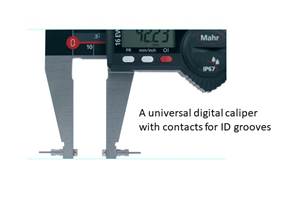Working With Your Working Gage Blocks
The uses of working gage blocks are as varied as the number of gage blocks in a large set. The working blocks have an intermediate grade and are often used in the inspection or calibration lab, but they may also be found on the shop floor.
Share





The uses of working gage blocks are as varied as the number of gage blocks in a large set. The working blocks have an intermediate grade and are often used in the inspection or calibration lab, but they may also be found on the shop floor. We are not talking about the master gage block set that is used as the corporate standard or the shop floor set that levels an old table. As part tolerances become tighter and the resolution of comparative gaging becomes higher, the use of working gage block sets for toolmaking and part inspection is widespread.
Of course, the most common use of the gage block is to provide a reference for direct measurement of distances between parallel surfaces, such as widths of grooves. The blocks can be used as a go/no go gage or as a means of setting up a comparative measurement. The ability to stack the gage block set to any length makes the gage invaluable as a tool in the inspection lab.
Another important use of the working block is for checking the performance of hand tools and gaging equipment. Micrometers and other hand measuring instruments can be checked for linearity (degradation of the micrometer thread). Using gage blocks of different sizes that are stepped, usually in equal increments over the measuring range of the measuring tool, provides a means for checking the performance of the tool. The gage blocks are also useful for setting a reference point on measuring tools where the measuring capacity of the gage is larger than the measuring range of the gage itself. For example, a 3-inch gage block would be used to set the 3-inch reference point on a 3 to 4-inch micrometer. With these measuring tools, the spindle does not touch the fixed contact, so a gage block provides a precision method of setting a starting point.
Limit gage sets can be created with two sets of gage blocks or gage block stacks set to the high and low tolerance limits. These sets would consist of gage block stacks with added contact elements or end jaws combined to the limits specified. They provide an easy-to-assemble and reliable means of producing temporary gaging for an unexpected application. In the long run, however, it is more economical to have a fixed gage made for these applications, as assembly and disassembly is time consuming and subject to stacking error.
In inspection, a frequent use of these blocks is to set up for comparison or transfer measurements during surface plate work. Using a single block or stack for a height reference is the common approach. By adding another gage block or end jaw that overhangs the block, an inside dimension can be established. A base, holding rods and end jaws are often found in a gage block accessory kit. They allow the assembly area to perform medium accuracy comparisons with surface plate work. Finally, the use of gage blocks and a sine plate on the surface plate create a very precise angle setup. The double requirement of accurate length and perpendicularity to the base is a perfect use of the working gage block. Using fairly straightforward trig, the right angle reference set up by the blocks and the known length of the sine plate make for easy angle setup.
Gage blocks need preparation before they can work. The process includes making sure that they are recently certified, checked for nicks and burrs and stabilized for the temperature of the work area.
With care and careful handling, working gage blocks can contribute significantly to a manufacturer's productivity.
Related Content
How to Calibrate Gages and Certify Calibration Programs
Tips for establishing and maintaining a regular gage calibration program.
Read MoreChoosing the Correct Gage Type for Groove Inspection
Grooves play a critical functional role for seal rings and retainer rings, so good gaging practices are a must.
Read MoreParts and Programs: Setup for Success
Tips for program and work setups that can simplify adjustments and troubleshooting.
Read MoreThe Many Ways of Measuring Thickness
While it may seem to be a straightforward check, there are many approaches to measuring thickness that are determined by the requirements of the part.
Read MoreRead Next
Registration Now Open for the Precision Machining Technology Show (PMTS) 2025
The precision machining industry’s premier event returns to Cleveland, OH, April 1-3.
Read More5 Rules of Thumb for Buying CNC Machine Tools
Use these tips to carefully plan your machine tool purchases and to avoid regretting your decision later.
Read MoreSetting Up the Building Blocks for a Digital Factory
Woodward Inc. spent over a year developing an API to connect machines to its digital factory. Caron Engineering’s MiConnect has cut most of this process while also granting the shop greater access to machine information.
Read More




























